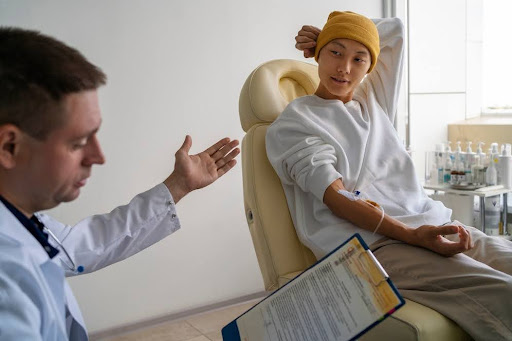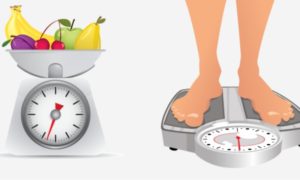1. Understanding Fibroids
Fibroids, or myoma (as it is called in medical terminology), is a non-cancerous tumor in the female reproductive system that is often found during a woman’s middle and last years. In the diagram on the left, the round circle in the middle is a depiction of the location of where the fibroid is located. There are three types of fibroids categorized by the location of where it grows. Intramural fibroids are located within the uterine wall; submucosal fibroids are located inside the uterine cavity; subserosal fibroids are located on the outside of the uterine wall. Sizes of the fibroids range from small (like a seed or a pea) to bigger than a cantaloupe. The larger ones can cause the abdomen to enlarge as shown in this picture. This is a sure sign of multiple fibroids. The exact cause of fibroids is unknown. It is known that the female hormones estrogen and progesterone are associated with the tumor because fibroids tend to grow during reproductive years and pregnancy, and they stop growing or decrease during menopause. Research has also proven that a single cell of the smooth muscular tissue of the uterus, myometrium, multiplies itself many times to form a firm rubbery mass. This cell is a fibroid. These tumors can also become cancerous. One out of a thousand will develop into a form of cancer called leiomyosarcoma. This is often found in postmenopausal women. Fibroids are most common in women aged 30-40 years but can occur at any age. This illness has both mental and physical consequences for every woman. Fortunately, the physical consequences such as infertility, miscarriage, and early onset of labor can all be resolved. If you’re looking for more info on fibroids Singapore, the Vascular and Interventional Centre can help.
2. The Impact of Fibroids on Daily Life
The feeling of being bloated is another common symptom of fibroids. Again, there is no research to explain why this is so, but many women with fibroids of a certain size (usually around the size of a 4 month pregnancy) feel as though there is something foreign within their abdomen. Some describe it as a feeling of fullness or pressure; for others it may be a feeling of being swollen or inflamed in the abdominal area. Women are usually quite surprised to learn that their discomfort and appearance is due to fibroids. Fibroids can also cause prolonged menses that can result in anemia. Anemia can cause feelings of weakness, fatigue and depression. Some women are unable to maintain an active lifestyle because their energy level is so low. This can affect personal time as well as professional or academic success. During an era when there is an increased focus on physical fitness, these women may find it difficult to relate to their peers and feel discouraged when they compare their activity level to others. High achievers may feel a sense of failure due to their lack of productivity at work or home. And so, it is clear that fibroids can have a diverse impact on physical, emotional and social well-being.
When people are asked about the impact of fibroids on their daily lives, they often express feelings of frustration and diminished quality of life. While some may relate acute or chronic symptoms to their fibroids, others may not recognize that the range and intensity of their symptoms are caused by fibroids. Women with fibroids may experience many symptoms and illnesses. Some alternate between periods of severe and mild discomfort, while others feel a constant, dull pain. Fibroid discomfort can be barely noticeable, while conversely, its impact can be severe. Symptoms and impact of fibroids can vary greatly among women. Reasons for differences in symptomology are not clearly understood, but may be related to size and location of fibroids. Fibroids are most commonly found in women age 30-40 years, with the likelihood of occurrence increasing with age. During the reproductive years, the likelihood of having fibroids approaches around 70%.
3. Vascular and Interventional Centre: Specialized Expertise
Fibroids are non-cancerous (benign) tumors of the uterus and are common in women of child-bearing age. Although fibroids do not always cause symptoms, their size and location can lead to problems for some women including pelvic pain, heavy menstrual bleeding, and pressure on the bladder or bowel. If you are experiencing symptoms and your GP has diagnosed fibroids, and medical treatment has proven to be ineffective, it is time to consider seeing one of our fibroid specialists to discuss whether you are a candidate for fibroid embolization. Fibroid Embolization is a well-established, simple, and highly effective treatment. It is a minimally invasive technique, performed in the Vascular and Interventional Centre, where the blood vessels feeding the fibroids are blocked which leads to shrinkage of the fibroids and improvement of the symptoms. The procedure is performed by a specially trained doctor called a vascular surgeon. Fibroid Singapore can be troublesome, but the team at the Vascular and Interventional Centre offers minimally invasive treatment, such as embolization, to effectively address them.
4. Advanced Treatments for Fibroids
Uterine Fibroid Embolization (UFE) is a minimally invasive treatment for fibroids that blocks the blood flow to the fibroids, causing them to shrink. After making a tiny nick in the skin, the physician places a catheter into the artery that supplies blood to the fibroid. Small particles are injected through the catheter and into the artery. The particles block the blood flow to the fibroid and cause it to shrink and die. UAE can be performed as an outpatient. Recovery time is generally 7-10 days although this can vary. UAE is successful in controlling heavy bleeding and other symptoms.
As technology and understanding of fibroids evolves, there are an increasing number of alternative treatments for women with symptomatic fibroids that allow you to avoid surgery. These treatments typically cause the fibroids to shrink and die over a period of weeks to months. It is important to consult a physician who is both knowledgeable and experienced in performing the specific procedures to discuss the treatment that is best for you.
5. Regain Control and Enjoy Life Again
In addition to effects on bleeding and pain, fibroids can cause a variety of urinary or bowel symptoms that can lead to a loss of normal function and discomfort in these areas. Releasing all women from these symptoms and sending them back to their normal healthy lives is an important goal.
The fibroid bleeding – it’s a nuisance and a hassle. Many women report flood-like bleeding, which is not only aggravating but can also lead to iron deficiency and anemia due to the blood loss. Frequent and/or heavy bleeding can inflict an overwhelming preoccupation with the location and availability of restrooms. This can be extremely embarrassing and limit a woman’s social and professional life. Imagine being in a business meeting or at a social gathering and being terrified that you might bleed through your clothes. UFE is very effective in controlling fibroid-related bleeding. Embolization is effective in treating uterine fibroids by blocking their blood supply, leading to their shrinkage and alleviating associated symptoms.


